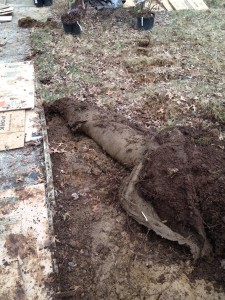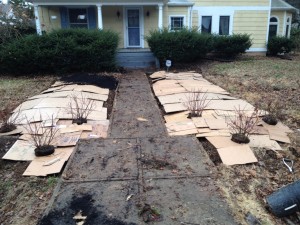Mulch: Materials and Strategies
By Danylo Kosovych, Owner
Organic Edible Gardens LLC
There are many benefits to mulch, including improved soil moisture retention, weed suppression, increase in organic matter and aesthetic quality, but like most things, a sound approach goes a long way, if applied too thickly, it can create problems like root collar disorders in trees, anaerobic soil conditions and killing of tender perennials. There are multiple material options to consider as well as the ideal time of year to apply mulch.
The best time of the year to apply mulch to your garden beds is the early spring before perennials emerge. It is best to wait until most of the snow has finished, if applied too early, the mulch will be flattened and weathered come spring time. Perennial garden plants will emerge through mulch if not applied to thickly. Attempting to mulch after perennials emerge requires significantly more care because recently sprouted perennials can be damaged if covered by mulch. Mulch applied in spring prevents annual weed seed germination in garden beds and can smother already emerged perennial weeds.
There are many mulch materials available, but the most widely available are shredded bark, leaves and wood. The best mulch resembles most what nature produces. Nature’s mulch is a combination of leaves, downed twigs and trees, therefore one could assume that leaf mulch from the county facility is the best option. While it does produce rich dark soil when used over a number of years, it contains a lot of weed seeds and can counteract the weed suppression benefit of mulch. Bark mulch is high in tannins which over time lowers the ph of our already acidic soil. There is never such a high concentration of bark around plants in nature; it is always accompanied with wood and leaves. No material is perfect, but out of the three, wood mulch is my mulch of choice because it keeps weeds down, looks attractive and has balanced nutrients.
If you would like to smother a section of weeds or lawn consider using a compostable material like cardboard. Weed fabric should be avoided in garden beds. It never breaks down! If not removed annually, perennial weeds begin to seed themselves on top of the fabric, growing roots throughout the fabric, making it more difficult to remove the weeds. It also stratifies soil, not allowing the organic matter of broken down mulch to mix with the lower layers of soil. As a result, roots remain at the surface. Over time, the fabric becomes clogged with organic matter, preventing water from infiltrating into lower layers of the soil. Cardboard, on the other hand can be left in place because it breaks down over time, improving the soil.


